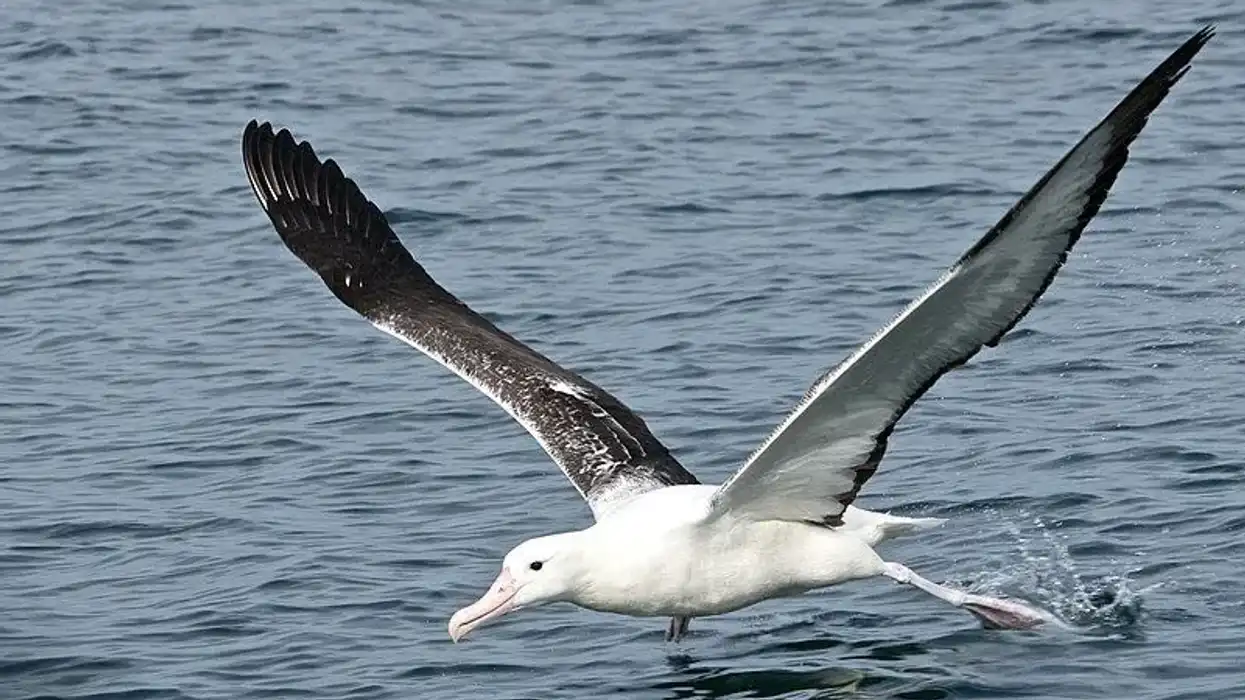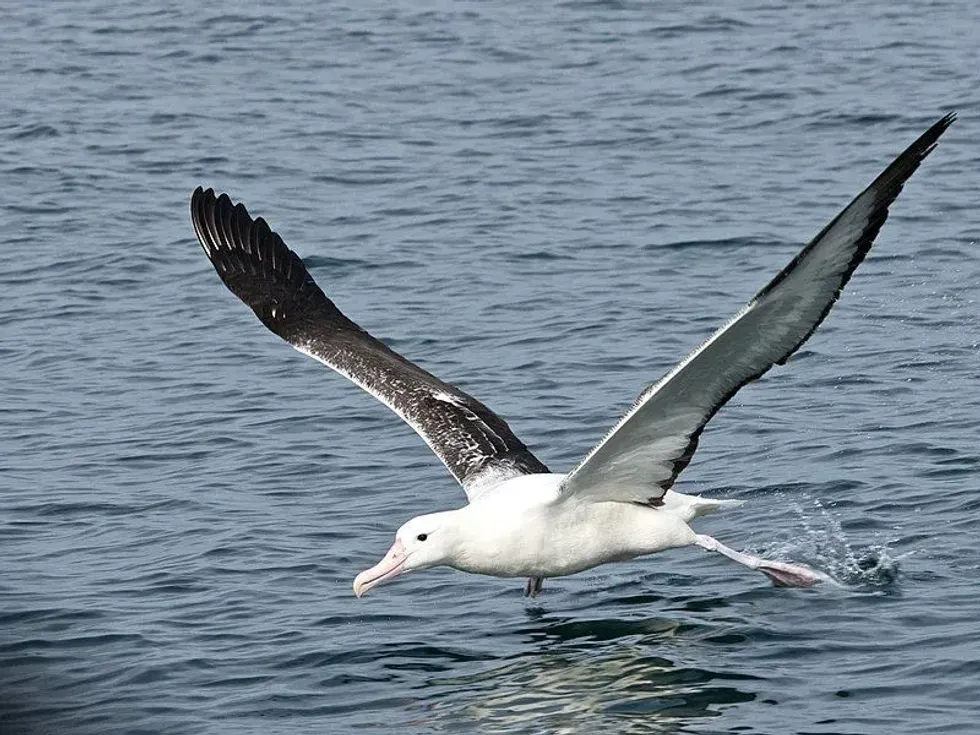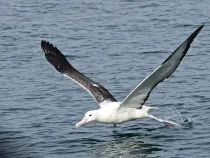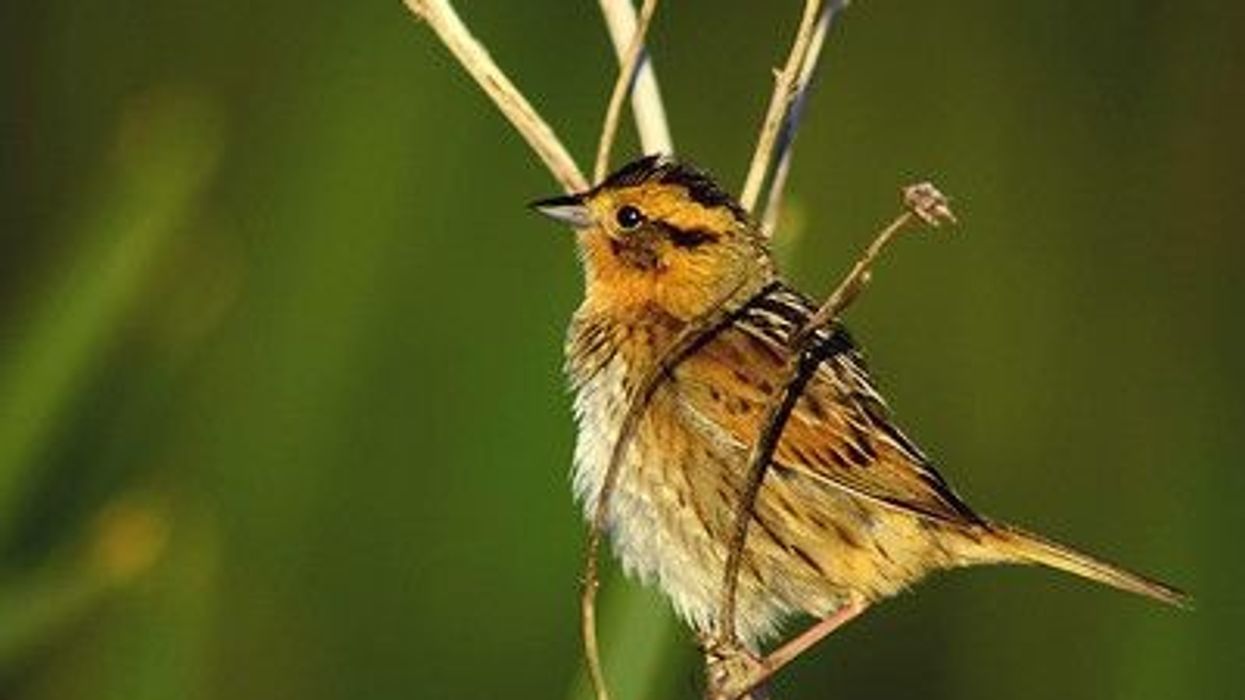Fun Southern Royal Albatross Facts For Kids

The Southern Royal Albatross (Diomedea epomophora) is the second-largest seabird in the albatross family, next to the Wandering Albatross. This seabird is endemic to New Zealand and has an average wingspan of 3 m (9 ft).
Most of the Southern Royal Albatross breeding population is found on the subantarctic Campbell Island, while some are on the Auckland Islands. They are cousins with the Northern Royal Albatross, which breeds at Taiaroa Head and the Chatham Islands.
Like other seabirds, the population of Southern Royal Albatross is threatened by longliners and trawlers across Pacific, Indian, and Atlantic Oceans.
Read on to learn fascinating facts about the Southern Royal Albatross (Diomedea epomophora). You might also enjoy our other facts articles on the Laysan albatross and wandering albatross.
Southern Royal Albatross Interesting Facts
What type of animal is a Southern Royal Albatross?
The Southern Royal Albatross is a large-size bird with a wingspan of up to 10.8 ft (3.3m). It is also the whitest and one of the biggest species in the albatross family.
What class of animal does a Southern Royal Albatross belong to?
The Southern Royal Albatross is a bird. It is one of the endangered seabirds in the world.
How many Southern Royal Albatrosses are there in the world?
There are approximately less than 30,000 Southern Royal Albatrosses in the world recorded in 1997. Around 9000 pairs of this estimated total reside in Campbell Island.
Where does a Southern Royal Albatross live?
The majority of the Southern Royal Albatrosses breed in Campbell Island and only less than 100 pairs in the Auckland Islands (Enderby, Adams, and Auckland). A few birds were also spotted nesting with the Northern Royal Albatrosses at Taiaroa Head.
During the non-breeding season, they spend most of the time at sea. These seabirds circumnavigate over southern New Zealand and Campbell Island, and even as far as southern Chile, Uruguay, and Argentina where they can feed on squid and fish.
What is a Southern Royal Albatross's habitat?
The Southern Royal Albatross habitat is on small remote islands usually around tussock grasslands and mega herb fields which house their nests. Although, they also prefer nesting on open fields where they can take off and land at ease.
About 80% of a Southern Royal Albatross's life is spent directly exposed to the cold, treacherous, open southern oceans. In Campbell Island where 99% of them live, the Southern Royal Albatross nest is at 180-350 m mid-elevation.
Who do Southern Royal Albatrosses live with?
The Southern Royal Albatross live in loose colonies and scattered pairs when breeding. But, they are often solitary at sea. A colony gathers when there is food, often around fishing boats as the seabirds scavenge food for their chicks and themselves.
How long does a Southern Royal Albatross live?
The average life span of a Southern Royal Albatross is 58 years, although some live up to 80 years.
How do they reproduce?
Southern Royal Albatrosses are monogamous and are committed to a long-term relationship with only one partner. The female Southern Royal Albatross lays only one egg biennially or every two years, as it takes about a year to rear a single chick.
The breeding season takes place from October to December. The chicks hatch around February and fledge sometime in October.
The Southern Royal Albatrosses are known to be responsible parents - incubating the egg and rearing the young until they mature at about 6-12 years old. By this age, they begin to find a partner to start mating.
Breeding parents usually take a year of rest in between attempts. During this time, they cross the Southern Ocean, usually avoiding the cold Antarctic seas, before returning to their breeding areas.
What is their conservation status?
The Southern Royal Albatross is classified as Vulnerable. The population is slowly recovering from its downfall in the late 19th until the early 20th century.
The four predator-free islands where the Southern Royal Albatross breeds are nature reserves and now declared World Heritage Sites. These are Campbell, Enderby, Adams, and Auckland islands in New Zealand. However, a rising number of Dracophyllum scrub is spreading on Campbell and Enderby Islands is a growing threat to the nesting areas of these birds.
Southern Royal Albatross Fun Facts
What do Southern Royal Albatrosses look like?
The adult male and female Southern Royal Albatross have the same plumage. They are generally covered in white plumage with some blackish parts on their wings and some coverts in the carpal area.
The tail is also white with a bit of black and brown on the side and tip. Some birds may also have brown and gray patterns on the neck, breast, and flanks.
The bill is pale pink with a creamy white tip and black edges. The eyes are dark brown while the legs and feet are also pale pink or light gray.
The juvenile Southern Royal Albatross slightly differs from the adults. The young ones have darker wings with black speckles on their back, flanks, crown, and tail. They outgrow their darker color and become whiter as they mature.
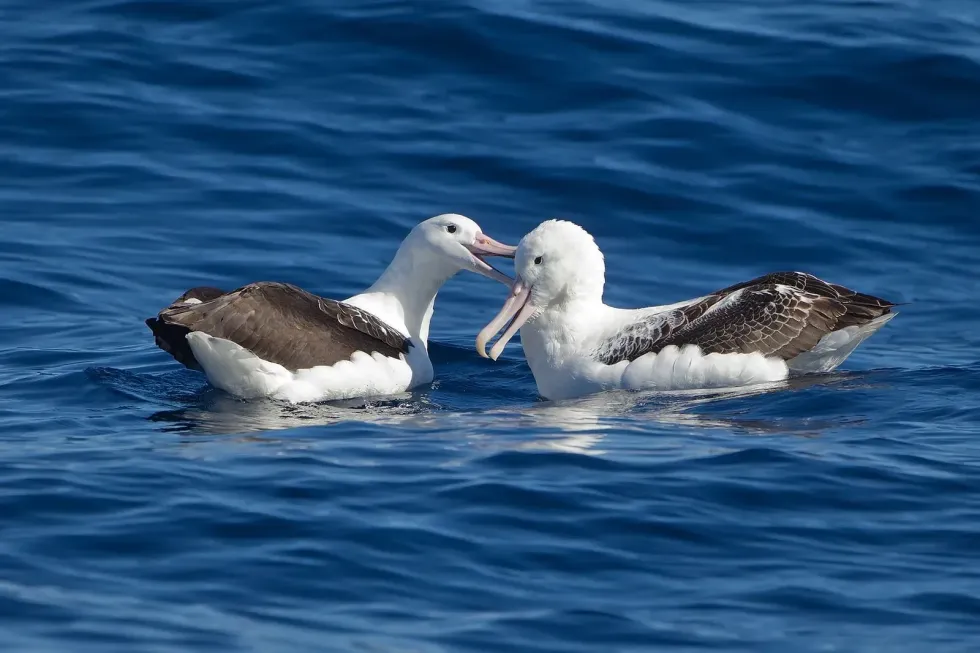
How cute are they?
Despite their size, the Southern Royal Albatross can be really cute. They are particularly mesmerizing during flight displays as they glide and swing through the wind, oftentimes hunting for food. Their take-off and landing performance may be floppy but can be awkwardly cute.
How do they communicate?
Often expressing high-pitched screaming bray, the Southern Royal Albatross exhibits an elaborate display with a variety of calls such as croaking, yapping, and clucking calls. During courtship, their body language includes 'bill-circling', 'sky-calling', 'flank-touching' of the bill as they show a full spread of their wings.
This type of ritual is usually demonstrated to form a pair before the breeding season on either land or sea.
Outside of courtship, the adult Southern Royal Albatrosses are mostly quiet at sea except when competing for food. When they feel threatened, they would clap their bill rapidly producing a distinct rattling sound.
How big is a Southern Royal Albatross?
The Southern Royal Albatross size can grow up to 11.5 ft (3.5 m) horizontally. The average Southern Royal Albatross wingspan measures about the length of a tiger, ranging from 9.5-10.8 ft (2.9-3.3 m). The male bird is also generally bigger than the female.
How fast can a Southern Royal Albatross fly?
The Southern Royal Albatross can fly at more than 70 mph (112 kph). They travel long distances across land and waters with an average total distance of 100,000 mi per year (160,000 km per year).
With its large wingspan, this gorgeous seabird displays a spectacular flight mainly by gliding and sliding through the wind. Above the waters, it finds its momentum slowing through the wind and turning to the sea to gain speed again.
However, these birds are not able to fly in calm weather as they cannot maintain a continuous flapping flight. When the wind dies, the Southern Royal Albatross are forced to float in the waters.
How much does a Southern Royal Albatross weigh?
A Southern Royal Albatross weighs an average of 20 lb (9 kg). That's about half a sack of rice! They are slightly heavier than most colonies of albatross. Male Southern Royal Albatrosses are also seen heavier than the females.
What are their male and female names of the species?
Except for the slight discrepancy in size, there is not much difference between the male and female Southern Royal Albatross physical appearance, as well as in names. They are both called Diomedea epomophora in scientific terms.
What would you call a baby Southern Royal Albatross?
The immature Southern Royal Albatrosses are called gams.
What do they eat?
The Southern Royal Albatross eats mostly squid and fish. Although, they also savor on crustaceans, salps, and animal carcasses. These seabirds often scavenge on ocean surfaces but also take shallow plunges just beneath the surface.
Are they dangerous?
The Southern Royal Albatross can spend months solitary at sea, without touching lands. They naturally grow to protect themselves not just from other land species, but also from ocean predators that may attack them from the water surface - including tiger sharks.
The Southern Royal Albatross can be dangerous to any threat that may approach them. Most especially, they are not used to human interaction and it is not advisable to disrupt them in their natural habitat.
Would they make a good pet?
The Southern Royal Albatross is not an ideal pet as they will not survive outside of their natural habitat. They are endangered species and should not be exploited, but rather protected.
Did you know...
Being a beautiful seabird, the Southern Royal Albatross can be very majestic in the sky. However, they do not possess the best take-off and landing skills.
With their wings spread, they first start a long marathon to take off from the ground or water surface. For the seabirds, this is a skill that they must master.
Landing on the ground is particularly very tricky for the Southern Royal Albatross as they cannot flap their huge wings as much as other bird species. Without flapping abilities, braking can be hard which usually results in crash landings and injuries.
Why is the Southern Royal Albatross endangered?
Being a dominant species in its natural habitat, the Southern Royal Albatross has only a few predators. Rather, the population of the Southern Royal Albatross was heavily diminished by several human activities.
During the sheep farming era between 1890-1931, their natural habitat was severely damaged by the burning of vegetation, grazing, and destruction of nesting areas. Not to mention, people were also into the consumption of birds at the time.
Pigs, cats, and other mammals were also a problem because they destroy the albatross eggs and babies. In the 1950s-1960s, the islands where the albatrosses reside became protected and the mammals that prey on them were slowly removed.
The population has been recovering since then but the problem remains with the major fishing industries. Similar to other seabirds, some firms see the royal albatrosses as threats to their businesses.
Which albatross is the largest one?
The largest in the albatross family is the Wandering Albatross. It weighs up to 26 lb (12 kg) and is a little heavier than the South Royal Albatross.
The wingspan of the Wandering Albatross can measure from 96-144 in (2.5-3.5 m), the longest in all bird species. They somewhat share the same lifestyle with the royal albatrosses as they also spend the most time at sea except when feeding and breeding.
Although, the breeding cycle of the Wandering Albatross is slightly longer than that of the Southern Royal Albatross. Most Wandering Albatrosses breed in South Georgia Island, Crozet Islands, Kerguelen Islands, Prince Edward Islands, and Macquarie Island, in New Zealand.
Here at Kidadl, we have carefully created lots of interesting family-friendly animal facts for everyone to discover! Learn more about some other birds including hardhead, or a Spix's macaw.
You can even occupy yourself at home by drawing one on our Southern Royal albatross coloring pages.
We Want Your Photos!
More for You
See All
Bachelor of Communication specializing in Media Arts Production, Communication, and Media Studies

Hannah BowyerBachelor of Communication specializing in Media Arts Production, Communication, and Media Studies
A fitness enthusiast with a passion for helping people find their best selves, Hannah is a qualified personal trainer who is currently training to be a yoga instructor. She is also knowledgeable about mindfulness and meditation. Hannah has lived and worked in many different countries across Asia and the Americas over the last four years, and loves to write about her travels. Her dynamic nature is reflected in her love for running, whether it's towards a plane or a personal best.
Bachelor of Law

Abdulqudus MojeedBachelor of Law
A versatile professional with a passion for creative writing and technology. Abdulqudus is currently pursuing his Bachelor of Law from the University of Lagos and has experience as a tutor, intern assistant, and volunteer. He possesses strong organizational skills and is a detail-oriented person.
Disclaimer
1) Kidadl is independent and to make our service free to you the reader we are supported by advertising. We hope you love our recommendations for products and services! What we suggest is selected independently by the Kidadl team. If you purchase using the Buy Now button we may earn a small commission. This does not influence our choices. Prices are correct and items are available at the time the article was published but we cannot guarantee that on the time of reading. Please note that Kidadl is a participant in the Amazon Services LLC Associates Program, an affiliate advertising program designed to provide a means for sites to earn advertising fees by advertising and linking to Amazon. We also link to other websites, but are not responsible for their content.
2) At Kidadl, we strive to recommend the very best activities and events. We will always aim to give you accurate information at the date of publication - however, information does change, so it’s important you do your own research, double-check and make the decision that is right for your family. We recognise that not all activities and ideas are appropriate for all children and families or in all circumstances. Our recommended activities are based on age but these are a guide. We recommend that these ideas are used as inspiration, that ideas are undertaken with appropriate adult supervision, and that each adult uses their own discretion and knowledge of their children to consider the safety and suitability. Kidadl cannot accept liability for the execution of these ideas, and parental supervision is advised at all times, as safety is paramount. Anyone using the information provided by Kidadl does so at their own risk and we can not accept liability if things go wrong.
3) Because we are an educational resource, we have quotes and facts about a range of historical and modern figures. We do not endorse the actions of or rhetoric of all the people included in these collections, but we think they are important for growing minds to learn about under the guidance of parents or guardians.
